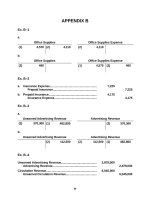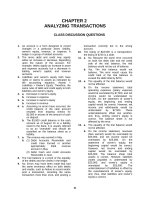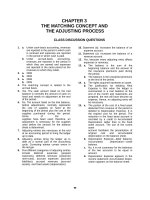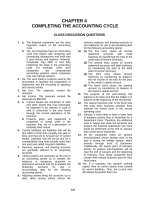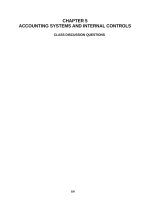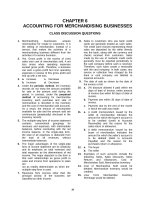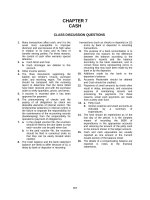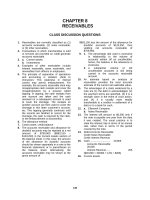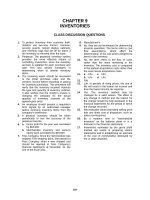Solution manual accounting 21e by warreni ch 06
Bạn đang xem bản rút gọn của tài liệu. Xem và tải ngay bản đầy đủ của tài liệu tại đây (233.2 KB, 80 trang )
CHAPTER 6
ACCOUNTING FOR MERCHANDISING BUSINESSES
CLASS DISCUSSION QUESTIONS
1. Merchandising
businesses
acquire
merchandise for resale to customers. It is
the selling of merchandise, instead of a
service, that makes the activities of a
merchandising business different from the
activities of a service business.
2. Yes. Gross profit is the excess of (net)
sales over cost of merchandise sold. A net
loss arises when operating expenses
exceed gross profit. Therefore, a business
can earn a gross profit but incur operating
expenses in excess of this gross profit and
end up with a net loss.
3. a. Increase
c. Decrease
b. Increase
d. Decrease
4. Under the periodic method, the inventory
records do not show the amount available
for sale or the amount sold during the
period. In contrast, under the perpetual
method of accounting for merchandise
inventory, each purchase and sale of
merchandise is recorded in the inventory
and the cost of merchandise sold accounts.
As a result, the amount of merchandise
available for sale and the amount sold are
continuously (perpetually) disclosed in the
inventory records.
5. The multiple-step form of income statement
contains
conventional
groupings
for
revenues and expenses, with intermediate
balances, before concluding with the net
income balance. In the single-step form,
the total of all expenses is deducted from
the total of all revenues, without
intermediate balances.
6. The major advantages of the single-step
form of income statement are its simplicity
and its emphasis on total revenues and
total expenses as the determinants of net
income. The major objection to the form is
that such relationships as gross profit to
sales and income from operations to sales
are
not as readily determinable as when the
multiple-step form is used.
7. Revenues from sources other than the
principal activity of the business are
classified as other income.
8. Sales to customers who use bank credit
cards are generally treated as cash sales.
The credit card invoices representing these
sales are deposited by the seller directly
into the bank, along with the currency and
checks received from customers. Sales
made by the use of nonbank credit cards
generally must be reported periodically to
the card company before cash is received.
Therefore, such sales create a receivable
with the card company. In both cases, any
service or collection fees charged by the
bank or card company are debited to
expense accounts.
9. The date of sale as shown by the date of
the invoice or bill.
10. a. 2% discount allowed if paid within ten
days of date of invoice; entire amount
of invoice due within 60 days of date of
invoice.
b. Payment due within 30 days of date of
invoice.
c. Payment due by the end of the month
in which the sale was made.
11. a. A credit memorandum issued by the
seller of merchandise indicates the
amount for which the buyer's account is
to be credited (credit to Accounts
Receivable) and the reason for the
sales return or allowance.
b. A debit memorandum issued by the
buyer of merchandise indicates the
amount for which the seller's account is
to be debited (debit to Accounts
Payable) and the reason for the
purchases return or allowance.
12. a. The buyer
b. The seller
13. Examples of such accounts include the
following: Sales, Sales Discounts, Sales
Returns
and
Allowances,
Cost
of
Merchandise Sold, Merchandise Inventory.
14. Cost of Merchandise Sold would be
debited; Merchandise Inventory would be
credited.
15. Loss
From
Merchandise
Inventory
Shrinkage would be debited.
37
EXERCISES
Ex. 6–1
a.
$490,000 ($250,000 + $975,000 – $735,000)
b. 40% ($490,000 ÷ $1,225,000)
c. No. If operating expenses are less than gross profit, there will be a net
income. On the other hand, if operating expenses exceed gross profit, there
will be a net loss.
Ex. 6–2
$15,710 million ($20,946 million – $5,236 million)
Ex. 6–3
a.
b.
c.
d.
Purchases discounts, purchases returns and allowances
Transportation in
Merchandise available for sale
Merchandise inventory (ending)
Ex. 6–4
a.
Cost of merchandise sold:
Merchandise inventory,
May 1, 2005............................................
Purchases...................................................
Less: Purchases returns and
allowances....................................
Purchases discounts......................
Net purchases............................................
Add transportation in.................................
Cost of merchandise
purchased........................................
Merchandise available for sale..................
Less merchandise inventory,
April 30, 2006........................................
Cost of merchandise sold....................
b. $489,000 ($1,420,000 – $931,000)
$ 121,200
$985,000
$23,500
21,000
44,500
$940,500
11,300
951,800
$1,073,000
142,000
$ 931,000
Ex. 6–5
1.
The schedule should begin with the January 1, not the December 31,
merchandise inventory.
2. Purchases returns and allowances and purchases discounts should be
deducted from (not added to) purchases.
3. The result of subtracting purchases returns and allowances and purchases
discounts from purchases should be labeled “net purchases.”
4. Transportation in should be added to net purchases to yield cost of
merchandise purchased.
5. The merchandise inventory at December 31 should be deducted from
merchandise available for sale to yield cost of merchandise sold.
A correct cost of merchandise sold section is as follows:
Cost of merchandise sold:
Merchandise inventory, January 1, 2006. .
Purchases...................................................
Less: Purchases returns and allowances$14,000
Purchases discounts......................
6,000
Net purchases............................................
Add transportation in.................................
Cost of merchandise purchased.........
Merchandise available for sale..................
Less merchandise inventory,
December 31, 2006...............................
Cost of merchandise sold.........................
Ex. 6–6
Net sales: $3,010,000 ($3,570,000 – $320,000 – $240,000)
Gross profit: $868,000 ($3,010,000 – $2,142,000)
Ex. 6–7
a. Selling expense, (1), (3), (8)
b. Administrative expense, (2), (5), (6), (7)
c. Other expense, (4)
$132,000
$600,000
20,000
$580,000
7,500
587,500
$719,500
120,000
$599,500
Ex. 6–8
THE MERIDEN COMPANY
Income Statement
For the Year Ended June 30, 2006
Revenues:
Net sales......................................................................
Rent revenue...............................................................
Total revenues.........................................................
Expenses:
Cost of merchandise sold..........................................
Selling expenses.........................................................
Administrative expenses............................................
Interest expense.........................................................
Total expenses........................................................
Net income.........................................................................
$5,400,000
30,000
$5,430,000
$3,240,000
480,000
300,000
47,500
4,067,500
$1,362,500
Ex. 6–9
1.
Sales returns and allowances and sales discounts should be deducted from
(not added to) sales.
2. Sales returns and allowances and sales discounts should be deducted from
sales to yield "net sales" (not gross sales).
3. Deducting the cost of merchandise sold from net sales yields gross profit.
4. Deducting the total operating expenses from gross profit would yield income
from operations (or operating income).
5. Interest revenue should be reported under the caption “Other income” and
should be added to Income from operations to arrive at Net income.
6. The final amount on the income statement should be labeled Net income, not
Gross profit.
A correct income statement would be as follows:
THE PLAUTUS COMPANY
Income Statement
For the Year Ended October 31, 2006
Revenue from sales:
Sales...........................................................
Less: Sales returns and allowances........
Sales discounts...............................
Net sales................................................
Cost of merchandise sold..............................
Gross profit.....................................................
Operating expenses:
Selling expenses........................................
Transportation out.....................................
Administrative expenses...........................
Total operating expenses.....................
Income from operations.................................
Other income:
Interest revenue.........................................
Net income.......................................................
$4,200,000
$81,200
20,300
101,500
$4,098,500
2,093,000
$2,005,500
$ 203,000
7,500
122,000
332,500
$1,673,000
66,500
$1,739,500
Ex. 6–10
a.
b.
c.
d.
$25,000
$210,000
$477,000
$192,000
e.
f.
g.
h.
$40,000
$520,000
$757,500
$690,000
Ex. 6–11
a.
CALLOWAY COMPANY
Income Statement
For the Year Ended January 31, 2006
Revenue from sales:
Sales...........................................................
Less: Sales returns and allowances........
Sales discounts...............................
Net sales................................................
Cost of merchandise sold..............................
Gross profit.....................................................
Operating expenses:
Selling expenses........................................
Administrative expenses...........................
Total operating expenses.....................
Income from operations.................................
Other expense:
Interest expense........................................
Net income.......................................................
$925,000
$60,000
20,000
80,000
$845,000
560,000
$285,000
$120,000
80,000
200,000
$ 85,000
7,500
$ 77,500
b. The major advantage of the multiple-step form of income statement is that
relationships such as gross profit to sales are indicated. The major
disadvantages are that it is more complex and the total revenues and
expenses are not indicated, as is the case in the single-step income
statement.
Ex. 6–12
a.
b.
c.
d.
e.
f.
Cash..............................................................................
Sales........................................................................
6,900
Cost of Merchandise Sold...........................................
Merchandise Inventory...........................................
4,830
Accounts Receivable...................................................
Sales........................................................................
7,500
Cost of Merchandise Sold...........................................
Merchandise Inventory...........................................
5,625
Cash..............................................................................
Sales........................................................................
10,200
Cost of Merchandise Sold...........................................
Merchandise Inventory...........................................
6,630
Accounts Receivable—American Express.................
Sales........................................................................
7,200
Cost of Merchandise Sold...........................................
Merchandise Inventory...........................................
5,040
Credit Card Expense....................................................
Cash.........................................................................
675
Cash..............................................................................
Credit Card Expense....................................................
Accounts Receivable—American Express............
6,875
325
6,900
4,830
7,500
5,625
10,200
6,630
7,200
5,040
675
7,200
Ex. 6–13
It was acceptable to debit Sales for the $235,750. However, using Sales Returns
and Allowances assists management in monitoring the amount of returns so that
quick action can be taken if returns become excessive.
Accounts Receivable should also have been credited for $235,750. In addition,
Cost of Merchandise Sold should only have been credited for the cost of the
merchandise sold, not the selling price. Merchandise Inventory should also have
been debited for the cost of the merchandise returned. The entries to correctly
record the returns would have been as follows:
Sales (or Sales Returns and Allowances)...................
Accounts Receivable..............................................
235,750
Merchandise Inventory.................................................
Cost of Merchandise Sold......................................
141,450
235,750
141,450
Ex. 6–14
a. $7,350 [$7,500 – $150 ($7,500 × 2%)]
b. Sales Returns and Allowances....................................
Sales Discounts......................................................
Cash.........................................................................
Merchandise Inventory.................................................
Cost of Merchandise Sold......................................
7,500
150
7,350
4,500
4,500
Ex. 6–15
(1) Sold merchandise on account, $12,000.
(2) Recorded the cost of the merchandise sold and reduced the merchandise
inventory account, $7,800.
(3) Accepted a return of merchandise and granted an allowance, $2,500.
(4) Updated the merchandise inventory account for the cost of the merchandise
returned, $1,625.
(5) Received the balance due within the discount period, $9,405. [Sale of $12,000,
less return of $2,500, less discount of $95 (1% × $9,500).]
Ex. 6–16
a.
b.
c.
d.
$18,000
$18,375
$540 (3% × $18,000)
$17,835
Ex. 6–17
a.
$7,546 [Purchase of $8,500, less return of $800, less discount of $154 ($7,700
× 2%)]
b. Merchandise Inventory
Ex. 6–18
Offer A is lower than offer B. Details are as follows:
List price.....................................................................
Less discount.............................................................
Transportation.............................................................
A
$40,000
800
$39,200
625
$39,825
B
$40,300
403
$39,897
$39,897
Ex. 6–19
(1)
(2)
(3)
(4)
Purchased merchandise on account at a net cost of $8,000.
Paid transportation costs, $175.
An allowance or return of merchandise was granted by the creditor, $1,000.
Paid the balance due within the discount period: debited Accounts Payable,
$7,000, and credited Merchandise Inventory for the amount of the discount,
$140, and Cash, $6,860.
Ex. 6–20
a.
b.
c.
Merchandise Inventory.................................................
Accounts Payable...................................................
7,500
Accounts Payable.........................................................
Merchandise Inventory...........................................
1,200
Accounts Payable.........................................................
Cash.........................................................................
Merchandise Inventory...........................................
6,300
7,500
1,200
6,174
126
Ex. 6–21
a.
b.
c.
d.
e.
Merchandise Inventory.................................................
Accounts Payable—Loew Co.................................
12,000
Accounts Payable—Loew Co......................................
Cash.........................................................................
Merchandise Inventory...........................................
12,000
Accounts Payable*—Loew Co.....................................
Merchandise Inventory...........................................
2,940
Merchandise Inventory.................................................
Accounts Payable—Loew Co.................................
2,000
Cash..............................................................................
Accounts Payable—Loew Co.................................
940
12,000
11,760
240
2,940
2,000
940
*Note: The debit of $2,940 to Accounts Payable in entry (c) is the amount of cash
refund due from Loew Co. It is computed as the amount that was paid for the
returned merchandise, $3,000, less the purchase discount of $60 ($3,000 × 2%).
The credit to Accounts Payable of $2,000 in entry (d) reduces the debit balance in
the account to $940, which is the amount of the cash refund in entry (e). The
alternative entries below yield the same final results.
c.
d.
e.
Accounts Receivable—Loew Co.................................
Merchandise Inventory...........................................
2,940
Merchandise Inventory.................................................
Accounts Payable—Loew Co.................................
2,000
Cash..............................................................................
Accounts Payable—Loew Co......................................
Accounts Receivable—Loew Co............................
940
2,000
Ex. 6–22
a.
$10,500
b. $4,160 [($4,500 – $500) × 0.99] + $200
c. $4,900
d. $3,960
e. $834 [($1,500 – $700) × 0.98] + $50
2,940
2,000
2,940
Ex. 6–23
a. At the time of sale
b. $4,000
c. $4,280
d. Sales Tax Payable
Ex. 6–24
a.
b.
Accounts Receivable...................................................
Sales........................................................................
Sales Tax Payable...................................................
9,720
Cost of Merchandise Sold...........................................
Merchandise Inventory...........................................
6,300
Sales Tax Payable.........................................................
Cash.........................................................................
9,175
9,000
720
6,300
9,175
Ex. 6–25
a.
b.
c.
Accounts Receivable—Beta Co. .................................
Sales........................................................................
11,500
Cost of Merchandise Sold...........................................
Merchandise Inventory...........................................
6,900
Sales Returns and Allowances....................................
Accounts Receivable—Beta Co.............................
900
Merchandise Inventory.................................................
Cost of Merchandise Sold......................................
540
Cash..............................................................................
Sales Discounts............................................................
Accounts Receivable—Beta Co.............................
10,388
212
11,500
6,900
900
540
10,600
Ex. 6–26
a.
b.
c.
Merchandise Inventory.................................................
Accounts Payable—Superior Co............................
11,500
Accounts Payable—Superior Co.................................
Merchandise Inventory...........................................
900
Accounts Payable—Superior Co.................................
Cash.........................................................................
Merchandise Inventory...........................................
10,600
Ex. 6–27
11,500
900
10,388
212
a. debit
b. debit
c. credit
d. debit
e. debit
f. debit
Ex. 6–28
Balance Sheet Accounts
Income Statement Accounts
100
400
Revenues
410 Sales
411 Sales Returns and
Allowances
412 Sales Discounts
500
Expenses
510 Cost of Merchandise Sold
520 Sales Salaries Expense
521 Advertising Expense
522 Depreciation Expense—
Store Equipment
523 Store Supplies Expense
524 Transportation Out
529 Miscellaneous Selling
Expense
530 Office Salaries Expense
531 Rent Expense
532 Depreciation Expense—
Office Equipment
533 Insurance Expense
534 Office Supplies Expense
539 Miscellaneous Administrative Expense
600
Other Expense
610 Interest Expense
Assets
110 Cash
112 Accounts Receivable
114 Merchandise Inventory
115 Store Supplies
116 Office Supplies
117 Prepaid Insurance
120 Land
123 Store Equipment
124 Accumulated Depreciation—
Store Equipment
125 Office Equipment
126 Accumulated Depreciation—
Office Equipment
200
Liabilities
210 Accounts Payable
211 Salaries Payable
212 Notes Payable
(Short-Term)
300
Owner's Equity
310 Kimberly Skilling, Capital
311 Kimberly Skilling, Drawing
312 Income Summary
Note: The order of some of the accounts within subclassifications is somewhat
arbitrary, as in accounts 115–117 and accounts 521–524. In a new business, the
order of magnitude of balances in such accounts is not determinable in advance.
The magnitude may also vary from period to period.
Ex. 6–29
Cost of Merchandise Sold...........................................
Merchandise Inventory...........................................
Ex. 6–30
(b)
(d)
(e)
(f)
(g)
(j)
Cost of Merchandise Sold
Sales
Sales Discounts
Sales Returns and Allowances
Salaries Expense
Supplies Expense
11,550
11,550
Ex. 6–31
a.
2003:
2002:
2.07 [$58,247,000,000 ÷ ($30,011,000,000 + $26,394,000,000)/2]
2.24 [$53,553,000,000 ÷ ($26,394,000,000 + $21,385,000,000)/2]
b. These analyses indicate a decrease in the effectiveness in the use of the
assets to generate profits. This decrease is probably due to the slowdown in
the U.S. economy during 2002–2003. However, a comparison with similar
companies or industry averages would be helpful in making a more definitive
statement on the effectiveness of the use of the assets.
Ex. 6–32
a.
4.13 [$12,334,353,000 ÷ ($2,937,578,000 + $3,041,670,000)/2]
b. Although Winn-Dixie and Zales are both retail stores, Zales sells jewelry at a
much slower velocity than Winn-Dixie sells groceries. Thus, Winn-Dixie is
able to generate $4.13 of sales for every dollar of assets. Zales, however, is
only able to generate $1.53 in sales per dollar of assets. This makes sense
when one considers the sales rate for jewelry and the relative cost of holding
jewelry inventory, relative to groceries. Fortunately, Zales is able to counter
its slow sales velocity, relative to groceries, with higher gross profits, relative
to groceries.
Appendix 1—Ex. 6–33
a. and c.
SALES JOURNAL
Date
2006
Aug.
Invoice
No.
3
8
19
26
80
81
82
83
Account Debited
Post.
Ref.
Adrienne Richt...............
K. Smith..........................
L. Lao..............................
Cheryl Pugh....................
Cost of Merchandise
Sold Dr.
Accts. Rec. Dr.
Merchandise
Sales Cr.
Inventory Cr.
12,000
10,000
9,000
14,000
45,000
(11)(41)
4,000
5,500
4,000
6,500
20,000
(51)(12)
b. and c.
PURCHASES JOURNAL
Date
Post
Ref.
Account Credited
Accounts Merchandise Other
Payable
Inventory Accounts Post.
Cr.
Dr.
Dr.
Ref. Amount
2006
Aug. 10 Draco Rug Importers..............
12 Draco Rug Importers..............
21 Draco Rug Importers..............
8,000
3,500
19,500
31,000
(21)
8,000
3,500
19,500
31,000
(12)
d.
Merchandise inventory, August 1.....................................
Plus: August purchases....................................................
Less: Cost of merchandise sold.......................................
Merchandise inventory, August 31...................................
$ 19,000
31,000
(20,000)
$ 30,000
OR
Quantity
2
1
1
2
*($4,000 + $3,500)
Rug Style
10 by 6 Chinese*
8 by 10 Persian
8 by 10 Indian
10 by 12 Persian
Cost
$ 7,500
5,500
4,000
13,000
$ 30,000
Appendix 2—Ex. 6–34
Sales..............................................................................
Income Summary....................................................
925,000
Income Summary..........................................................
Sales Discounts......................................................
Sales Returns and Allowances...............................
Cost of Merchandise Sold......................................
Selling Expenses.....................................................
Administrative Expenses........................................
Interest Expense.....................................................
847,500
Income Summary..........................................................
Mark Donovan, Capital............................................
77,500
Mark Donovan, Capital.................................................
Mark Donovan, Drawing..........................................
25,000
925,000
20,000
60,000
560,000
120,000
80,000
7,500
77,500
25,000
PROBLEMS
Prob. 6–1A
1.
SOMBRERO CO.
Income Statement
For the Year Ended November 30, 2006
Revenue from sales:
Sales...........................................................
Less: Sales returns and allowances........
Sales discounts...............................
Net sales................................................
Cost of merchandise sold..............................
Gross profit.....................................................
Operating expenses:
Selling expenses:
Sales salaries expense.........................
Advertising expense............................
Depreciation expense—store
equipment........................................
Miscellaneous selling expense............
Total selling expenses....................
Administrative expenses:
Office salaries expense.............................
Rent expense.............................................
Insurance expense.....................................
Depreciation expense—office
equipment................................................
Office supplies expense............................
Miscellaneous administrative expense....
Total administrative expenses.............
Total operating expenses..........................
Income from operations.................................
Other expense:
Interest expense........................................
Net income.......................................................
$1,802,400
$ 25,200
13,200
38,400
$1,764,000
1,284,000
$ 480,000
$252,000
33,960
5,520
1,320
$ 292,800
$ 49,200
26,580
15,300
10,800
1,080
1,440
104,400
397,200
$ 82,800
$
1,200
81,600
Prob. 6–1A Continued
2.
SOMBRERO CO.
Statement of Owner’s Equity
For the Year Ended November 30, 2006
Hector Rodrique, capital, December 1, 2005....................
Net income for the year.....................................................
Less withdrawals...............................................................
Increase in owner’s equity................................................
Hector Rodrique, capital, November 30, 2006..................
$321,600
$81,600
30,000
51,600
$373,200
Prob. 6–1A Continued
3.
SOMBRERO CO.
Balance Sheet
November 30, 2006
Assets
Current assets:
Cash............................................................
Accounts receivable..................................
Merchandise inventory..............................
Office supplies...........................................
Prepaid insurance......................................
Total current assets................................
Property, plant, and equipment:
Office equipment.......................................
Less accumulated depreciation.............
Store equipment........................................
Less accumulated depreciation.............
Total property, plant, and
equipment.........................................
Total assets.....................................................
$ 91,800
74,400
120,000
3,120
8,160
$297,480
$ 76,800
12,960
$ 63,840
$141,000
58,320
82,680
146,520
$444,000
Liabilities
Current liabilities:
Accounts payable......................................
Note payable (current portion)..................
Salaries payable.........................................
Total current liabilities............................
Long-term liabilities:
Note payable (final payment due 2016)....
Total liabilities.................................................
Owner’s Equity
Hector Rodrique, capital.................................
Total liabilities and owner’s equity................
$ 32,400
3,000
2,400
$ 37,800
33,000
$ 70,800
373,200
$444,000
Prob. 6–1A Concluded
4.
a.
The multiple-step form of income statement contains various sections
for revenues and expenses, with intermediate balances, and concludes
with net income. In the single-step form, the total of all expenses is
deducted from the total of all revenues. There are no intermediate
balances.
b.
In the report form of balance sheet, the assets, liabilities, and owner’s
equity are presented in that order in a downward sequence. In the
account form, the assets are listed on the left-hand side, and the
liabilities and owner’s equity are listed on the right-hand side.
Prob. 6–2A
1.
SOMBRERO CO.
Income Statement
For the Year Ended November 30, 2006
Revenues:
Net sales......................................................................
Expenses:
Cost of merchandise sold..........................................
Selling expenses.........................................................
Administrative expenses............................................
Interest expense.........................................................
Total expenses........................................................
Net income.........................................................................
$1,764,000
$1,284,000
292,800
104,400
1,200
1,682,400
$ 81,600
2.
SOMBRERO CO.
Statement of Owner’s Equity
For the Year Ended November 30, 2006
Hector Rodrique, capital, December 1, 2005....................
Net income for the year.....................................................
Less withdrawals...............................................................
Increase in owner’s equity................................................
Hector Rodrique, capital, November 30, 2006..................
$321,600
$81,600
30,000
51,600
$373,200
Prob. 6–2A Concluded
3.
SOMBRERO CO.
Balance Sheet
November 30, 2006
Assets
Liabilities
Current assets:
Cash.......................................
$ 91,800
Accounts receivable.............
74,400
Merchandise inventory.........
120,000
Office supplies......................
3,120
Prepaid insurance.................
8,160
Total current assets...........
Property, plant, and equipment:
Office equipment.................. $ 76,800
Less accum. depreciation.
12,960 $ 63,840
Store equipment...................
Less accum. depreciation.
Total property, plant,
and equipment.................
Total assets...............................
$141,000
58,320
$297,480
82,680
146,520
$444,000
Current liabilities:
Accounts payable............ $32,400
Note payable (current
portion)..........................
3,000
Salaries payable..............
2,400
Total current liabilities..
$ 37,800
Long-term liabilities:
Note payable (final
payment due 2016).......
33,000
Total liabilities....................
$ 70,800
Owner’s Equity
Hector Rodrique, capital....
373,200
Total liabilities and
owner’s equity.................
$444,000
Prob. 6–3A
Mar.
1 Accounts Receivable—Babcock Co..................
Sales...............................................................
7,500
1 Cost of Merchandise Sold..................................
Merchandise Inventory..................................
4,500
2 Cash.....................................................................
Sales...............................................................
Sales Tax Payable..........................................
8,480
2 Cost of Merchandise Sold..................................
Merchandise Inventory..................................
4,750
5 Accounts Receivable—North Star Company....
Sales...............................................................
16,000
5 Cost of Merchandise Sold..................................
Merchandise Inventory..................................
10,500
8 Cash.....................................................................
Sales...............................................................
Sales Tax Payable..........................................
6,519
8 Cost of Merchandise Sold..................................
Merchandise Inventory..................................
3,700
13 Accounts Receivable—American Express........
Sales...............................................................
6,500
13 Cost of Merchandise Sold..................................
Merchandise Inventory..................................
3,600
14 Accounts Receivable—Blech Co.......................
Sales...............................................................
7,500
14 Cost of Merchandise Sold..................................
Merchandise Inventory..................................
4,000
15 Cash.....................................................................
Sales Discounts..................................................
Accounts Receivable—North Star
Company...................................................
15,840
160
7,500
4,500
8,000
480
4,750
16,000
10,500
6,150
369
3,700
6,500
3,600
7,500
4,000
16,000
Prob. 6–3A Continued
Mar.
April
16 Sales Returns and Allowances...........................
Accounts Receivable—Blech Co..................
800
16 Merchandise Inventory.......................................
Cost of Merchandise Sold.............................
360
18 Accounts Receivable—Westech Company.......
Sales...............................................................
6,850
18 Accounts Receivable—Westech Company.......
Cash................................................................
210
18 Cost of Merchandise Sold..................................
Merchandise Inventory..................................
4,100
24 Cash.....................................................................
Sales Discounts..................................................
Accounts Receivable—Blech Co..................
6,633
67
27 Cash.....................................................................
Credit Card Expense...........................................
Accounts Receivable—American Express...
7,680
320
28 Cash.....................................................................
Sales Discounts..................................................
Accounts Receivable—Westech Company..
6,923
137
31 Transportation Out..............................................
Cash................................................................
1,275
31 Cash.....................................................................
Accounts Receivable—Babcock Co.............
7,500
3 Credit Card Expense...........................................
Cash................................................................
725
10 Sales Tax Payable...............................................
Cash................................................................
2,800
800
360
6,850
210
4,100
6,700
8,000
7,060
1,275
7,500
725
2,800
Prob. 6–3A Concluded
This solution is applicable only if the P.A.S.S. Software that accompanies the text is
used.
INTERSTATE SUPPLIES CO.
Trial Balance
April 10, 20—
110
111
112
115
116
117
120
121
210
212
220
310
311
410
411
412
510
520
521
522
523
524
529
530
531
532
533
534
539
610
710
Cash.........................................................................
Notes Receivable....................................................
Accounts Receivable..............................................
Merchandise Inventory...........................................
Office Supplies........................................................
Prepaid Insurance...................................................
Office Equipment....................................................
Accum. Depreciation—Office Equipment..............
Accounts Payable...................................................
Salaries Payable......................................................
Notes Payable..........................................................
Oscar Beamer, Capital.............................................
Oscar Beamer, Drawing..........................................
Sales........................................................................
Sales Returns and Allowance.................................
Sales Discounts......................................................
Cost of Merchandise Sold......................................
Sales Salaries Expense...........................................
Advertising Expense...............................................
Depreciation Expense—Store Equipment.............
Credit Card Expense...............................................
Transportation Out..................................................
Miscellaneous Selling Expense.............................
Office Salaries Expense..........................................
Rent Expense..........................................................
Depreciation Expense—Office Equipment............
Insurance Expense..................................................
Office Supplies Expense........................................
Miscellaneous Administrative Expense.................
Interest Revenue.....................................................
Interest Expense.....................................................
Totals.......................................................................
88,315
120,000
117,500
140,210
5,600
3,400
85,000
12,800
55,600
2,400
48,500
349,999
29,500
1,333,500
23,900
22,264
809,790
173,200
43,800
6,400
1,045
1,275
1,600
84,150
31,350
12,700
3,900
1,300
1,600
11,000
6,000
1,813,799
1,813,799
